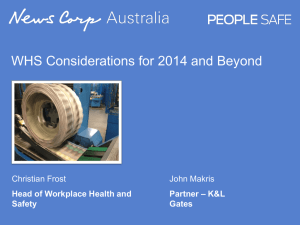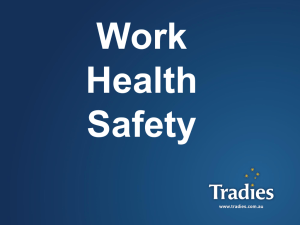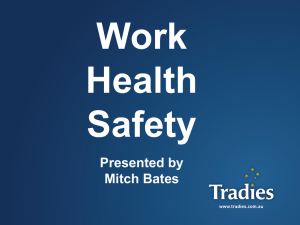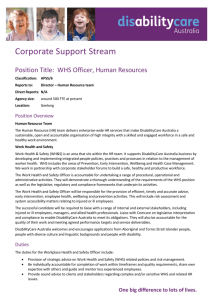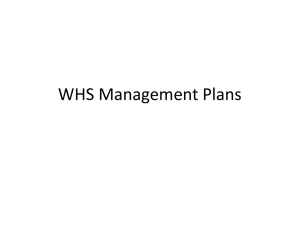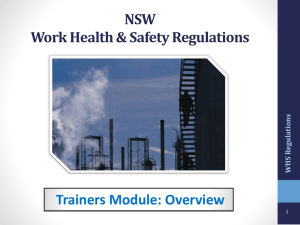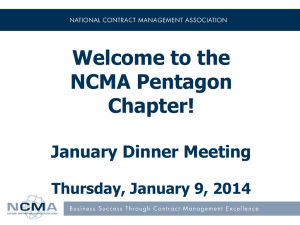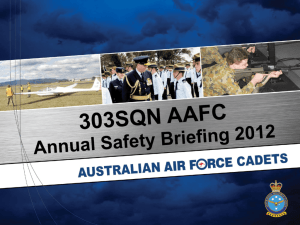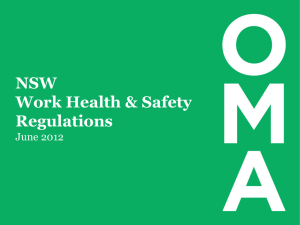WHS Act Presentation V7 2012 - 3 Wing Australian Air Force
advertisement
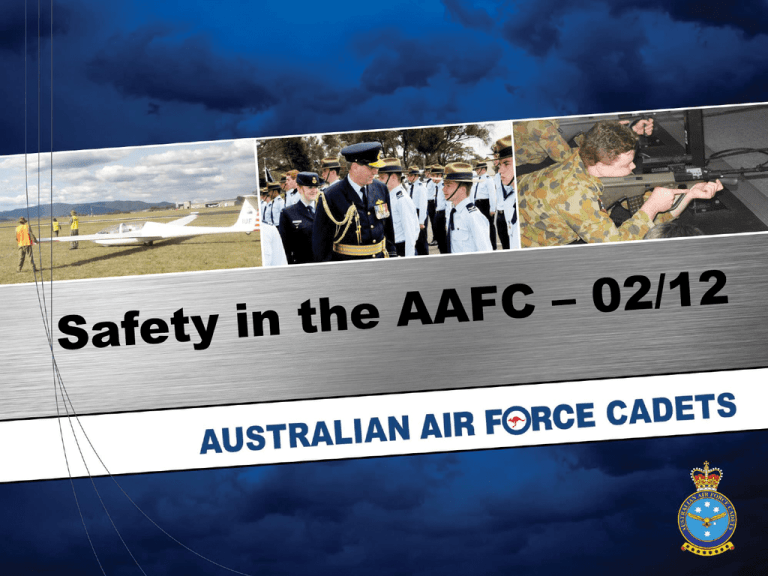
Learning Outcomes • Identify the key changes in the new Work Health Safety (WHS) laws • Summarise your responsibilities • Outline the consultation and participation provisions in the new laws that may impact you • Develop awareness in relation to implementation plan Chief of Air Force Commitment to Safety The Chief of Air Force released a Policy Statement on 1st October 2011 He said “Work health and safety (WHS) is paramount to our Air Force and I am committed to achieving our WHS goals and to providing appropriate resources to meet these goals. However, I need our entire workforce to be equally committed to WHS if the health and safety of our people is to be an integral part of our day-to-day business”. New Terminology • Officer - not a rank • Worker – everyone • Workplace – any approved AAFC activity Changes to Comcare • Comcare is the regulatory authority • Comcare investigators are now inspectors • Comcare Liaison Officer in Air Force Directorate of Defence Aviation and Air Force Safety (DDAAFS) Categories of Penalties There are three categories of penalties based on degrees of ‘culpability’ and the risk/degree of harm, these are: 1. reckless conduct exposing another to risk of death, serious injury or illness and is engaged in without reasonable excuse 2. failure to comply with WHS duty exposes another to risk of death, serious injury or illness 3. failure to comply with a WHS duty Duty of Care • Duty of Care is the duty you have, based on your responsibilities as a worker, taking into account your knowledge and skill level. • A breach of ‘Duty of Care’ occurs when you don’t follow procedures that you have been trained in that results in damage to a person or property. Due Diligence for ‘Officers’ Acquire and keep up-todate knowledge of WHS Understands the AAFC business and the hazards and risks associated with it Ensure AAFC has available for use, and uses, appropriate resources and processes to eliminate or minimise risks to WHS Ensure AAFC has processes for receiving and considering information regarding incidents, hazards and risks and responds in a timely way Ensure AAFC has and implements processes for complying with WHS duties On-going verification Reasonable Care • Participate safely in all AAFC activities • Ensure you do not initiate (or fail to halt) some process or activity which creates a risk or increases an existing risk to your own health and safety or that of other workers in or near the workplace • Use equipment provided in accordance with instructions (this includes personal protective equipment) Reasonable Care Cont. • Cooperate with supervisors to enable an ‘Officer’ to meet their WHS obligations i.e. follow the safety procedure, instructions and training given to you • Ensure that any identified hazards in your workplace are reported and the risk they create is managed until rectified through the chain of command or USC/WSA • Complete WHS incident notifications and reports within timeframes as required Examples of Wilful Failure of Duty • Staff in personal relationship with a Cadet • Cadet injured during unapproved activity • RAMP not read by participating staff and they don’t follow the risk controls (e.g. no First Aid kit if specified) Keep it Simple Our approach to safety needs to be systematic and uncomplicated. Four basic components: • Leadership • Governance • Incident Prevention • Incident Management and Safety Education If we satisfy these components, we will achieve our WHS goals. Safety Management System • • • • • Develop Safe Culture Safety Management Plan Safety Management System (SMS) Training Support through Cadet One Communication/Consultation • Identifying and Reporting Hazards and Issues • AC563 – Incident Reports Reporting Incidents Safety Incidents, as defined on the AC563 form, need to be reported within prescribed timeframes which are: • Fatality – within 2 hours (to Comcare, Cadet Branch and OHS Branch) • Serious Personal Injury, Dangerous Occurrence, Serious Near Misses and Exposure – must be reported within 24 hours (to Comcare, Cadet Branch and OHS Branch) • Minor Injury – within 28 days (to Cadet Branch and OHS Branch only) Risk Management Risk Management is a 4 Step Process that involves: • Hazard Identification • Risk Assessment • Risk Control • Monitoring and Review Hazard Identification • • • • • • Hazard Reports Workplace Inspections WHS Committee Discussions with staff and cadets Workplace observations Incidents and near misses Understand the Risks Knowledge of our workplace and organisational hazards allows proper assessment and understanding of our risks. Risk Management • The aim of Risk Management is to reduce the risk to As Low As Reasonable Practicable (ALARP) • Using the Hierarchy of Control is part of this process Risk Management Hierarchy of Control • Eliminate the Hazard • Substitute for something less hazardous • Isolate the hazard from the worker • Develop Engineering Controls • Employ Administrative Measures • Issue Personal Protective Equipment Resources and Templates • SSA, WSA, DAFLO, USC, USA • Hazard, Risk, Issues Register • Policy, Procedure and Standard Instructions Templates • Frequently Asked Questions (FAQ) sheets Role of WSA With the support of the DAFLO, the WSA will: • • • • • • • • • • • Provide safety advice to the Wing OC, and other Executives as required; Promote a positive safety culture within the Wing; Oversee the AC563 process for Wing and maintain, monitor and report on the outcomes; Mentor and monitor USC performance; Participate in the development and implementation of the Wing Safety Plan; Identify and implement WHS improvement strategies across the Wing; Monitor WHS performance within the Wing; Communicate WHS notices and procedures within the Wing; Prepare the monthly operations report on safety within the Wing; Participate in incident investigations, preparing reports and recommendations that implement corrective and preventative actions; and Coordinate WHS audits and address all hazards appropriately Role of DAFLO With the support of the Wing Safety Advisor, the DAFLO will: • Visit each unit and support COs and staff to meet WHS requirements. • Assist CO population of relevant information in templates at the unit level. • Identify gaps in Safety Management System, supporting COs to develop strategies to address the gaps. • Conduct RAAFSafe Audits. • Collating Hazard information and giving feedback to DGCADETs to enable Due Diligence requirements to be met Timeframes for Implementation 1st Quarter 2012 • Presentation to AAFC Senior Leadership Team • Presentation to COs • CO presentations to staff Jul 2012 • AAFC Senior Leadership Team development of Safety Management Plan Mar to Dec 2012 • DAFLO visit and support to units • Safety Staff development of templates • Cadet One enhancements Summary • Safety in the AAFC is about protecting all of our staff, cadets, volunteers and contractors from injury • Everyone in the AAFC is responsible for their own safety and the safety of those around them • You must report any safety hazards you see and report any safety incidents • Training and implementation of the AAFC Safety Management System will occur progressively in 2012 Questions?
